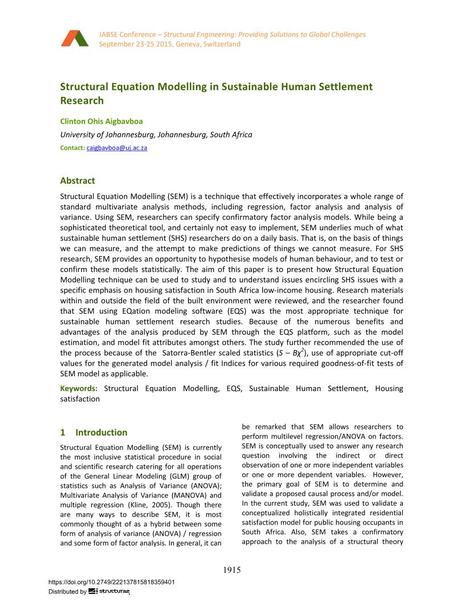Structural Equation Modelling in Sustainable Human Settlement Research

|
|
|||||||||||
Détails bibliographiques
| Auteur(s): |
Clinton Ohis Aigbavboa
|
||||
|---|---|---|---|---|---|
| Médium: | papier de conférence | ||||
| Langue(s): | anglais | ||||
| Conférence: | IABSE Conference: Structural Engineering: Providing Solutions to Global Challenges, Geneva, Switzerland, September 2015 | ||||
| Publié dans: | IABSE Conference Geneva 2015 | ||||
|
|||||
| Page(s): | 1915-1923 | ||||
| Nombre total de pages (du PDF): | 9 | ||||
| Année: | 2015 | ||||
| DOI: | 10.2749/222137815818359401 | ||||
| Abstrait: |
Structural Equation Modelling (SEM) is a technique that effectively incorporates a whole range of standard multivariate analysis methods, including regression, factor analysis and analysis of variance. Using SEM, researchers can specify confirmatory factor analysis models. While being a sophisticated theoretical tool, and certainly not easy to implement, SEM underlies much of what sustainable human settlement (SHS) researchers do on a daily basis. That is, on the basis of things we can measure, and the attempt to make predictions of things we cannot measure. For SHS research, SEM provides an opportunity to hypothesise models of human behaviour, and to test or confirm these models statistically. The aim of this paper is to present how Structural Equation Modelling technique can be used to study and to understand issues encircling SHS issues with a specific emphasis on housing satisfaction in South Africa low-income housing. Research materials within and outside the field of the built environment were reviewed, and the researcher found that SEM using EQation modeling software (EQS) was the most appropriate technique for sustainable human settlement research studies. Because of the numerous benefits and advantages of the analysis produced by SEM through the EQS platform, such as the model estimation, and model fit attributes amongst others. The study further recommended the use of the process because of the Satorra-Bentler scaled statistics (S – Bχ2), use of appropriate cut-off values for the generated model analysis / fit Indices for various required goodness-of-fit tests of SEM model as applicable. |
||||
| Mots-clé: |
établissement humain durable
|
||||
